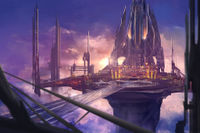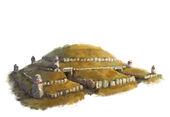
|
This map's not complete. It's just a piece. This page is flagged for further work under the Clan Odan-Urr article improvement drive.
Expected changes include: General updates
After improvement is complete, please place a note on the article's talk page and remove this message.
|
Kiast is a terrestrial planet in the Nilgaard sector of the Outer Rim territories inhabited by a subspecies of Sephi, who rule the planet from their highborne skyhooks and floating cities. Its inhospitable surface, and deadly sulfuric atmosphere surrounding it, are contrasted by clear blue skies above the thick cloud cover.
History
Early History - {~2000 BBY}
Recorded history on Kiast began with the settling of the planet, some 2000 years ago by Gand settlers. Finding the planet’s atmosphere more manageable than Type I atmospheres, they settled the toxic surface in an attempt to start several mining colonies. No permanent settlement was ever created, however the Gand stayed on the surface until this day, ferrying materials and ore from the surface and trading it with the galaxy.
Vatali Colonization - {~900 BBY - 722 BBY}
The Vatali first inhabited the system around 900 BBY, under Lord Ranorm Anasaye. As part of the larger Sephi dominion. Lord Ranorm Anasaye, married to a Sephi princess of royal birth, established a colony on the main planet of Kiast, on one of the larger inhabitable plateaus. During the next several decades, other colonies cropped up on the nearest mountain peaks and plateaus, expanding the domain of the Vatali significantly. By the fifth decade, it had become clear that to expand further and mine the valuable tibanna gas from the planet’s cloud cover, the Vatali would have to construct economical ships and inhabitable skyhooks. Thus the first city was build in the year 927 BBY — the Palace, Voraskel, was constructed.
The next century passed in relative security and peace. New ships were developed, working mostly on gas propelled or repulsor technology, significantly lowering the costs of the starships that were used in mining. New cities and platforms were built, and new gas mining technologies constructed. Each city was a refinery in and of itself, fully self-propelled and self-sustaining. Most of the rest of the platforms were used in intergalactic trade.
Independance - {722 BBY - 537 BBY}
Once Tanisad, Ranorm’s son, took to ruling the Empire, and with his mother’s death, Tanisad began two centuries of distancing from the mother dominion — the Sephi homeworld. Seeing himself as royalty and the true ruler of Kiast, but not lacking the subtlety to understand politics, Tanisad took to controlling the courts to his advantage and slowly turning the nobles against the Sephi domain. It took him nearly two centuries, and he never saw his dream fulfilled as the Sephi maintained a strong loyalty within the navy, something Tanisad could never break.
Meanwhile, the planet developed. Deals were made with the Gand on the surface, and in Tanisad’s reign, settlers were welcome from every corner of the galaxy. They quickly filled the rest of the inhabitable land masses, leaving only few free from colonization. Kyuzo, Melitto and Teedo, as well as Humans and other near-Humans, colonized the world with great speed, and in a mere 200 years outnumbered the Sephi three to one. This called for bylaws to be passed that made all colonists on Kiast subjects of the Vatali king.
It was during King Vatal’s reign that the Vatali intensified their aims to become more independent. Vatal was a fierce king who saw everything through self-interest and ambition, even going so far as creating laws that bound most of the colonist population to his undeniable rule. In effect he made the colonists his subjects and exploited their labor for the Empire’s gain.
While the Vatali dominion expanded to other worlds in the system, colonizing and exploiting whatever resources were available, the King instigated a coup against his Sephi overlords. The wayward King and his navy, coupled with colonists' ships and soldiers, overtook the loyalist forces. The War for Independence lasted for several long years before coming to an abrupt halt with the capitulation of the Sephi forces and their retreat from the Kiast system. Vatal proclaimed the Vatali Empire, reigning supreme over a whole system of worlds with an iron fist.
Quorahi Wars - {356 BBY - 75 BBY}
Emperor Vatal Anasaye died having fully established a strong dominion over the Kiast system. His reign was the peak in all of the Vatali Empire’s history. No outside force dared to enter his domain without proper respect and gifts and his armada of three hundred ships and airships dominated the whole system. It was truly the golden age of the Vatali Empire.
However, his civil and judiciary rule lacked the same attention to detail and care for his subjects. While he did expand the Empire, his subjects suffered under a dictatorship run by the military. Quorahi were treated as little better than slaves, building massive edifices for their noble overlords. Massive industrial cities were built across the planet, housing millions of people, all working on refineries both on the surface or in the air.
Vatal was succeeded by his daughter, Darsayi — an inexperienced monarch under the sway of the noble houses who looked to their interests above all else — and after many decades of the privileged ruling over the masses, a whisper of rebellion began to emerge. Any who spoke against the Empire and the military were held without trial, and often executed for treason. As the years passed the ember that was the beginning of the rebellion turned into a raging fire.
In 198 BBY the Quorahi turned on their masters, instigating a full scale rebellion and war against the Vatali Empire. This was the First Quorahi War and it took two years to bring an end to it. The Quorahi were given new laws and special provisions that protected them from the greed of the nobles and the Empress. Decades passed and as generations passed with them, the Empress slowly brought back the old laws in a new and rewritten form. Soon the nobles and royalty began exploiting the Quorahi again.
In 80 BBY, the Empress’ son, Taselm, saw an opportunity to ascend to the throne before all his brothers. He joined forces with a rebellious faction of the Quorahi and gained their loyalty through decisive action and the willingness to cripple the Empire’s efforts. Their cold war against the Vatali lasted for three years before they garnered enough support. In 77 BBY the Second Quorahi War began in earnest as the once-enslaved people turned against their masters again. The rebellion spread across the floating cities and swiftly took control of them within a span of months. The war lasted for two years before the Capital itself was assaulted and Empress Darsayi was executed before the whole Empire.
Taslem took the throne, as an obligation towards the Quorahi and to keep the nobles in check. The Empire survived but with radical changes to how they governed their people. Quorahi were given freedom and became free workers that the Empire employed. All species were accepted as subjects of His Imperial Majesty the Emperor of Kiast, and no person was valued more than the other in the eye of the law. The nobles, however, kept their wealth but lost the power they once held. It was a new dawn for the Vatali Empire.
Age of Reason - {75 BBY - Present}
At the time of his ascension, Emperor Taslem was already an aging Sephi. His rule was benevolent, open and welcoming to the masses. It was a second golden age of development and growth. The military was severely underpowered and maintained a constant vigil rather than a threatening presence. The focus was shifted on scientific research and trade with the outlying systems. The Empire grew and expanded to the farthest reaches of the Kiast system, mining and colonizing many worlds. The tensions between Quorahi and nobility subsided with time and the whole planet seemed to lull into a utopian-like state.
But it was not to last. Emperor Taslem passed away in the 70th year of his reign, leaving the throne empty and three possible successors. The direct lineage belonged to Essadan and Vauzem Anasaye, while the indirect lineage belonged to Taslem’s only surviving sister, the young Kaltani who was only three decades older than her nephews. Essadan was in line for the throne, as a direct successor and the eldest, however Vauzem had different plans.
During his father’s reign, Vauzem garnered the support of one third of the noble houses who wanted their power and privilege returned, seeing them as their birthright unlawfully taken. His plan was in motion years before his father ever died and its fruition came in the form of a coup. In one swift strike, the Voraskel Palace was taken and Essadan murdered in cold blood. Vauzem proclaimed himself Emperor of the Vatali domain, rechristening it into the Vauzem Dominion.
His reign was short lived. The rest of the noble houses, backed by the full might of the Vatali navy and the newly sworn Empress of the Vatali Empire, Kaltani Anasaye, descended upon the Vauzem Dominion. A battle for the Palace broke out as brother fought brother and cousin fought cousin. It was a stalemate until the Quorahi arrived in their industrial cities. Weapons bombarded the Vauzem ships and their floating castle until, at last, they retreated. The day was won and the Empire prevailed, though much of the old Palace was destroyed in the fighting.
The last war was in 4 BBY and Empress Katlani rules supreme and benevolently since then. Her nephew, Vauzem still hides somewhere on the planet and garners support to attack and reclaim his blood-given throne.
It is now 34 ABY and soon a new chapter begins.
Geography
 Kiast's habitable band of atmosphere, above the toxic surface
Kiast's habitable band of atmosphere, above the toxic surface
Kiast’s geology is rather unique. Due to the binary subdwarf system it formed in, Kiast has developed under high gravitational pressure from its parent stars into a small, but tectonically active planet. Its revolution is an imperfect ellipse, rather than a circle, which creates a very unique effect on the planet surface. Its proximity to the binary star, coupled with its irregular orbital path, has a straining effect on its tectonics as the planet is constantly pulled and pushed against the gravitational forces of the stars.
The surface becomes tense and crumbles as the planet nears the star in its summer months, excreting toxic gasses from multitudes of newly formed geysers. Due to the undersurface activity and the movement of the mantle, Kiast’s core is extremely active and creates a surprisingly strong gravitational field on the surface, holding the heavy gasses close to it.
Over billions of years, the surface has changed many times as tectonic plates — of which Kiast has twenty-seven — shift and create new mountain ranges. Some of these mountain peaks, and indeed large plateaus, penetrate the thick cloud cover and create natural islands of ground and greenery where colonies can be built.
The surface is a vast, alien area for any oxygen-breathing species. It is covered with a mixture of natural forming chlorine, carbon monoxide, sulfur hexafluoride and tibanna gases. The concoction is enough to kill anyone not wearing thick environmental suits on the surface. The pressure at surface level is easily sixty times standard, able to crush any living creature not adequately protected. Most of the surface, however, is covered in sulfuric oceans, formed from sulfuric rain and high pressure. The temperature on the surface is a scorching 200 degrees plus.
Despite its inhospitality, the surface is resource-rich and often exploited through mining in very expensive and very dangerous mining missions. The risks of tectonic activity in summer months often means that workers have to spend winters, when temperatures are low and the surface is increasingly more stable due to the planet’s orbital path.
Landmarks
Voraskel Palace
 Voraskel Palace
Voraskel Palace
The Voraskel Palace, nicknamed the “Steel Star,” is the administrative and economic capital of the Vatali Empire. This magnificent city hovers well above the planet’s noxious cloud layer, kept in the air by massive repulsorlift engines. Many of the system’s commercial institutions base their headquarters here, and it is also the seat of government of the Empire.
The Palace was first built in 927 BBY by King Ranorm, to serve as a tibanna gas refinery and royal residence. Since then, it has remained at the centre of Kiast’s history and politics. In 4 BBY the old Palace was mostly destroyed during a battle, but the Empress has since built an even more majestic complex in its place.
The floating construct is shaped like an irregular spinning top. The topmost structure is the Palace itself, and it rises up from the wide open-topped concourse. The city then narrows again below the concourse and tapers to the bottom levels.
The graceful spires of the Palace house the Imperial family, the Astral Throne, the government ministries, the Vatali Conclave, the High Court chamber, the justice courts and the military command of the Empire. The Palace rises above the concourse, which is the widest level of the city. Here a straight causeway connects the airship docks and landing platforms, goes through the financial district and enters the Palace, to terminate at the gates of the throne room. The concourse also accommodates the luxury apartments of the Sephi nobility, the Flight Academy, the Imperial botanical gardens and a retired museum-airship called the Age of Reason.
Below the rim of the concourse are the huge repulsorlift engines. These incorporate the tibanna refineries, though some of the old Ranorm-era infrastructure has been turned into art galleries. In the downward cone of the city are the dazzling high street and commercial districts, many affluent residential neighbourhoods and, directly below the Palace, the barracks and hangars of the Royal Guard. Descending further, Quorahi neighbourhoods cluster around the indoor Statuary Park. These residents are mainly employed in the service industry that centers around the wealthy Vatali nobility.
Essadan
 Essadan
Essadan
A cluster of cities built near the Voraskel Palace, Essadan lingers above a thin section of the toxins covering Kiast's surface. Oftentimes, this results in the mining operations on the surface being visible through the hazardous gases below the floating cities. Constructed during Vatal's reign, Essadan's cities are contained within dome-like structured fixed atop a stabilizer bearing numerous repulsorlifts.
Over time, it is possible for the cities to drift as the volatile surface below changes. These movements are not noticeable unless observed over long periods of time, but happen as the cities move to where lighter gases are more abundant to aid in lifting the structure. These cities are under the reigning monarch's direct rule, with each of the individual structures being managed under a landlord.
Undelm Domain
 Undelm
Undelm
Mirroring the design and function of Essadan, the Undelm domain is a collection of floating cities within the Vauzem Dominion. Closer to the toxic band than most cities, its cities are designed to shield themselves from toxins that might venture further from the surface as vents containing the gases open on the surface. However, as the Vauzem Domain is noted to be significantly less prosperous than the Vatali Empire, these cities are prone to widespread infections occurring among their residents. Many times, this is a result of their atmospheric shielding failing to prevent harmful toxins from leaking in. Unlike Essadan, the cities of Undelm are individually governed under a Sephi noble belonging to the Vauzem Dominion.
Ever since Kaltani Anasaye rose to power, Undelm's cities have been floating further from the Vatali Empire and across its borders of protection. While this would ordinarily make them prime targets for pirate factions, no documented attacks have been made.
Imperial Necropolis
The Imperial Necropolis is located on the plateau of Mudri in the southern temperate belt of Kiast. It is surrounded on most sides by taller peaks, creating a sheltered basin with a mild climate. The seven burial complexes of the Necropolis are scattered among the foothills of these peaks, while a small settlement occupies the center of the plateau.
The central settlement houses the population of permanent caretakers who look after the buildings and statues, tend the surrounding park and prepare the tombs for visits and ceremonies. The settlement also has landing platforms and facilities for tourists and pilgrims, who are permitted to see all but the sarcophagus chambers of the complexes. Visitors are expected to bring offerings of food, rich textiles or credit chips.
 Tanisad’s burial mound
Tanisad’s burial mound
The first to build at Mudri was King Tanisad. Over the seventh and sixth centuries BBY he constructed his own tomb and that of his father, probably intending to consolidate his legitimacy in the Kiast system in contrast with the faraway Sephi overlords. The model of construction that he established has remained essentially unchanged up to modern times. The burial complex is enclosed by walls, with a grand gate granting entrance. The avenue then leads to a shrine containing an enthroned statue of the deceased monarch, usually larger than life-size. The edifice also contains the historical archives pertinent to their reign. Surrounding the shrine is a statuary garden, with sculptures of warriors and state functionaries. At the far end of the enclosure is the burial mound; this covers a system of chambers containing treasures, murals, personal effects and the sarcophagus itself.
By far the largest complex on the plateau is that of Emperor Vatal, who exploited Quorahi labour to build a monumental shrine and a gigantic statue of himself, as well as a network of underground chambers that spanned many levels below the burial mound. Unfortunately, little remains of the riches that must have been stored in his tomb (and the same is true for those of Ranorm and Tanisad), because of the looting that took place in the First Quorahi War. The effects of the two Quorahi Wars can also be seen in the tomb of Empress Darsayi, which was never properly completed.
 Vatal’s shrine, containing his enthroned statue
Vatal’s shrine, containing his enthroned statue
The tomb enclosure of Emperor Taselm is made remarkable by its unique collection of statues, which for the first time included prominent Quorahi officials, rather than just Sephi. The statues were also rendered in an attitude of festivity, in contrast with the severe military style of previous complexes. Taselm was also the monarch who established the extensive park that surrounds the burial complexes.
The brief reign of Vauzem Anasaye saw the initiation of an ambitious project, as the Emperor set about building a colossal mausoleum on a high peak, overlooking all the other tombs. However, the war of succession of 4 BBY put a stop to that, and all that remains are the foundations and possibly some underground chambers. Nowadays the Necropolis caretakers only enter the site to ensure that visitors do not leave any offerings.
Empress Kaltani, the ruling monarch, has begun the construction of her tomb next to that of Vatal, and where her father’s memorial is one of tremendous might, hers promises to be a pleasing synergy of Sephi and Quorahi competences. The earthquakes of 29 and 30 ABY have delayed the project somewhat, as resources were redirected to the repair of the older tombs.
The liveliest period for the Necropolis is the annual festival of summer’s end, which sees the arrival of large crowds of pilgrims. The festivities culminate with the Imperial visit, when the Empress leads a ceremonial procession to each of the six tombs (excluding the Vauzem mausoleum) and makes offerings on behalf of her subjects. The sovereign will then select a particular tomb and enter the sarcophagus chamber on her own, to make personal propitiations and, it is said, petition the deceased monarch for guidance in the year ahead.
Atmosphere
Kiast’s atmosphere is unusually thick for a planet of its size, attributed to its high gravity and fast spin. Fully one third of the atmosphere is covered in a mixture of natural forming chlorine, carbon monoxide, sulfur hexafluoride and tibanna gases, making everything under that line deadly to oxygen breathing humanoids.
The second third of the atmosphere is covered in breathable gases, such as oxygen, nitrogen, helium and others. In all respects, it is breathable for all oxygen-breathing humanoids. Life thrives in this area in floating cities and airships that travel the vast expanses between isolated mountain peaks that penetrate the cloud cover.
The final third is the stratosphere and beyond, reaching all the way into space. This area is dominated by skyhooks and orbital space stations and shipyards that usually function as trading hubs for spacers.
Political Landscape
 A'lora Kituri and Turel Sorenn discuss Odan-Urr's involvement in the Vatali Empire
A'lora Kituri and Turel Sorenn discuss Odan-Urr's involvement in the Vatali Empire
The Vatali Empire
Long before the Jedi of Odan-Urr ever arrived, Kiast has been under the peaceful rule of its current monarch. Refined over centuries, the politics of Kiast have become set into a mixture of subtle intrigue and a pattern of rule that has not been broken in three millennia. The Vor floats above the unforgiving landscape, being the seat of most of the world’s politics.
The current monarch, Empress Kaltani Anasaye, has created a united Empire from several of the most prominent and largest surface cities on Kiast, solidifying her rule as the most advanced faction with ready access to mining, water and other necessities. Under peaceful rule, her advisors from the regions offer their thoughts in the Palace’s throne room. For matters that rise above trivial pursuits, the Vatali Conclave can be enacted to dispute matters ranging from war to interactions with outsiders.
The Vauzem Dominion
Not all agreed with the Vatali Empire's methods; nobles seeking their birthright promised under Vauzem's rule sought to manage their own affairs and remain isolated from the Vatali Empire. Lacking a leader after Vauzem himself was overthrown, the Dominion began to crumble as nobles squabbled over their assets. While a fair number hold legitimate reason for remaining in the leaderless Vauzem Dominion, others see it as an opportunity to gain wealth. While corrupt in practice, the Vauzem Dominion is far more democratic in political structures in Vauzem Anasaye's absence. Without a ruling monarch, the nobles have taken on the burden of responsibility, adhering to electoral and voting practices while refusing to appoint a new leader until Vauzem's fate can be determined.
Rumours have surfaced during Kaltani's reign of a civil war brewing between the Vatali Empire and the Vauzem Dominion, despite the Vauzem Dominion's lack of a standing military. Some have theorized that a war is to be fought using proxies allied to the Dominion, but no proof supports these allegations. Nonetheless, an unofficial cold war has been in progress between the two factions ever since Vauzem's defeat.
Quorahi
“The Folk”, or the Quorahi as they are known by the Vatali, are a major political faction comprised of the less wealthy and less fortunate species living on the planet. Mostly Humans, near-Humans, Kyuzo, Melitto and Teedo, these individuals are broken up into city states under direct rule from the Vatali Empire, though their rule is equally shunned and accepted. There is no general rule as to how the Quorahi are organized or how they function, but what is known is that the delicate balance between them and the Vatali has been preserved for centuries.
These sky nomads, as they are otherwise known, usually survive through trade and function as the working class for the Vatali. They are protected with Imperial treaties and laws that grant them significant freedoms in operating on the planet, and in return they supply the workforce for the Empire and its armies.
The Quorahi usually scavenge the surface of Kiast for any and all usable pieces of machinery, and trade or repurpose them to work in their cities and airships. They are well known for their tribal mentality and superstition, even though they are technologically superior to many other galactic species. Their loose collective is often considered a family mostly due to being so radically different to the Vatali Empire, and there is a certain camaraderie between individual Quorahi no matter their city, ship or home.
Despite this, wars and conflicts between rival captains are all too common and more than one city state has found its death below the clouds in feuds between sister cities, or at the hand of the Vatali Imperial Navy. Not all Quorahi are workers or loyal subjects of the Empire, however. Some are pirates and brigands, preying on defenseless transports and airships for tech and supplies. But a vast, vast majority are just simple folk trying to find their way in the galaxy.